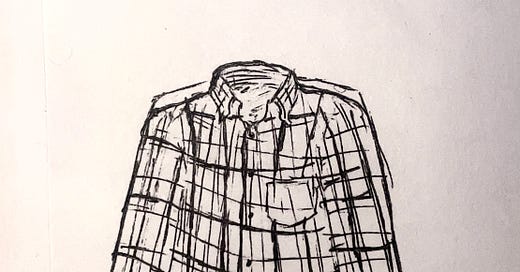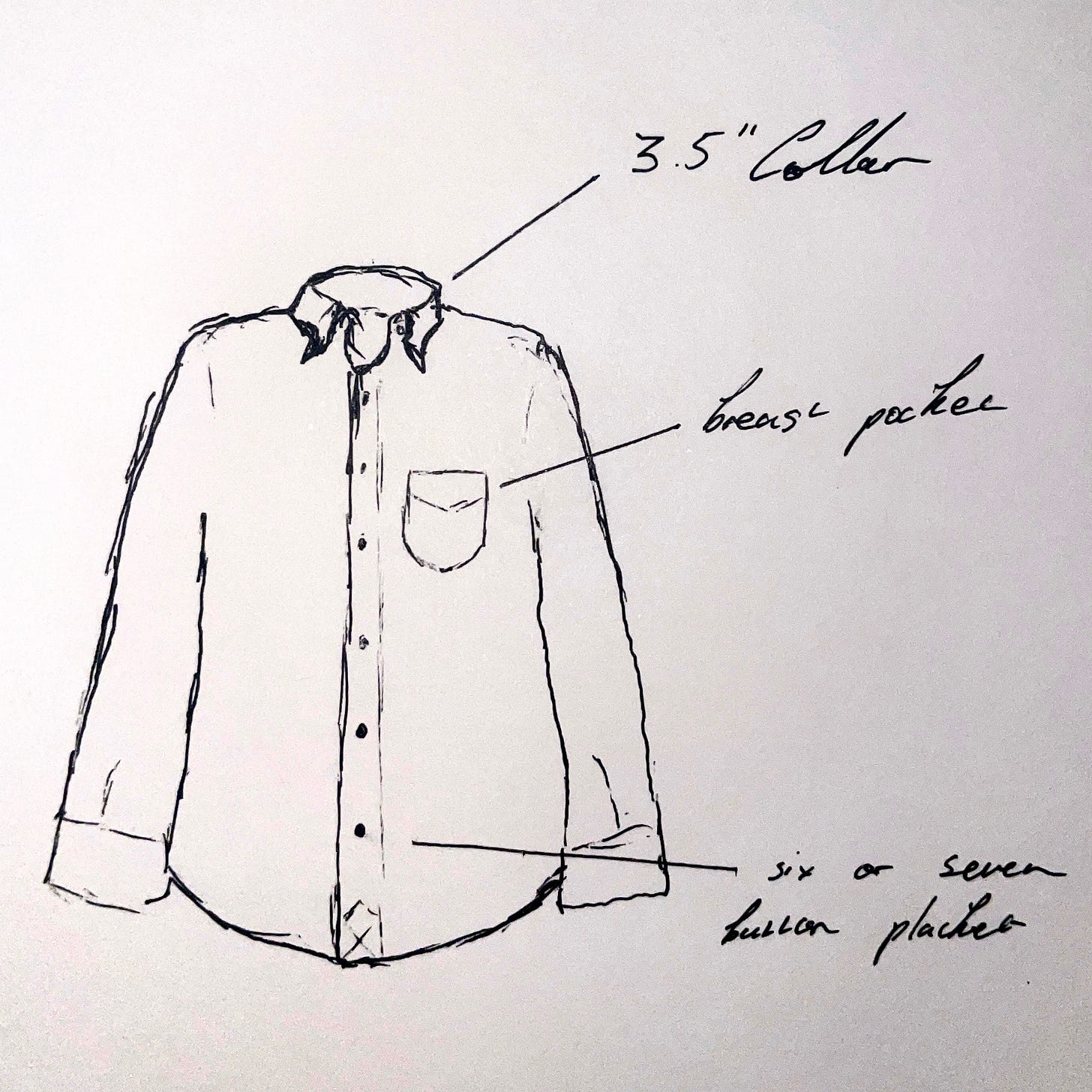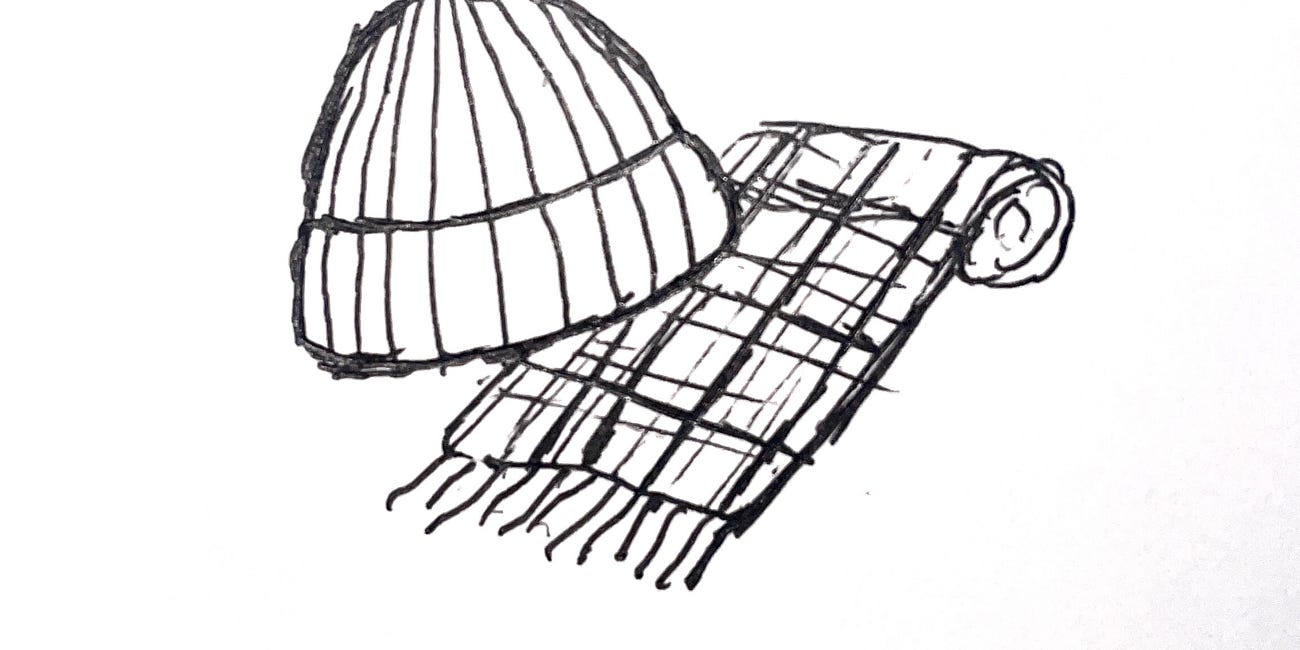Button Down the Hatches! A Guide to Casual Shirting in 2025
Consideration of cut, cloth, and club favourites
Up until about a year ago, I was guilty of a rather heinous crime of taste, that of wearing (or rather attempting to wear) formal shirts with casual outfits, and this woeful pursuit quite sadly continues to permeate our dress as a wider society, mostly being upheld by the straight-from-work-to-the-pub brigade. Of course, you and I know that it needn’t be this way, that if one wishes to wear a collared shirt casually, the simple addition of a button to the collar, and a change in the fabric, is all that must be done.
So, we’ve arrived at the OCBD? Well, yes and no. Whilst the oxford is the most popular option, without a doubt, there are a few more button-downs to consider. We will look today to condense every aspect of consideration for casual shirting into a handy pocket guide and then round out with a few club recommendations. This is the sort of article which has been written a hundred times in a hundred ways, mostly by virtue of shifting mediums. As such, I’m hoping to relate closely to the approach to Ivy and prep styles as they present themselves halfway through the twenty-twenties, and also to learn a little more about casualness along the way.
Welcome to this week’s meeting of The Prep Club, pick up a copy of last week’s bulletin here, or on your way out for a rant on personal vs. timeless style, and the nothingness we seem to be headed towards according to discourses. As always the club directory is available as a resource for labels and retailers specialising in collegiate apparel.
Small Favour: If you wouldn’t mind, please share this post, or the club as a whole, with a friend who you think might be interested, it would mean a whole lot. Please also subscribe if you haven’t yet, again, it makes a big difference.
Casualness
I’d say the casualness of any given garment exists most prominently on a comparative basis, it is more or less casual than any other garment. These comparisons are then set against a wider societal consensus, sort of like the CMB but for shirts and pants. The comparative structure has remained largely static, with consensus remaining, for example, that a navy blazer is more formal than a tweed sport coat, but the wider societal perception of the formality of all garments has generally relaxed over time. Think back to when you couldn’t get into nightclubs in jeans.
There are, however, certain embodied characteristics which inform these consensuses. Chiefly, drape and comfort, though the latter is a little muddy, flannel trousers for example are both more comfortable and more formal than raw jeans. Both these aspects are informed by cut and cloth, and as such those will be the focus of this guide.
Anatomy
To begin, let us consider the bones of the garment, the features which make a button-down shirt more casual, but that too distinguish it from the likes of a Western or lumberjack. These aspects exist in symbiosis with the cloths which we will cover next, that is to say that they are details of construction which are found on shirts cut from those cloths.
Starting at the front, we’ve already alluded to the button-down collar though that’s bleeding obvious given it’s in the name. If you’re after that classic ivy roll (and let’s be honest you probably are, it’s lovely) then the collar should be at least 3.5” in length and unlined for the best results. There’s scope too for a much slimmer collar in a wider spread which can be seen from Aime Leon Dore, Universal Works, we’re mostly concerned with the classic look today but they bare mentioning. Then, as we move down, expect to see either six or seven buttons on full placket shirt, or three to four on a half placket popover. Popovers are a rare sight these days, but a true staple of the sixties ivy canon, great to diversify a collection. We’re also likely to see a breast pocket but ****let’s not kid ourselves, these are an affectation, useful on rare occasions to hold pens or glasses on a temporary basis, it’s there, again, to lend a further casualness, open or flat pocket both are nice to have for this reason.
At the back we arrive first at the possibility of a collar back button, an affectation with mysterious origins, it needn’t be there but it’s a sign that consideration was taken when designing the garment as a whole, (in general this is not a rule of thumb). Then there’s the yoke, there are a lot people who will tell you where a yoke should end in relation to your shoulders I’m not one of those people. Beneath that we have a locker loop the third in our trusty trio of esoteric affectations which exist mostly as an indicator of casualness snd shirt nerdery. Origins of the loop are disputed between GANT and sailors short of space on ships. As with breast pockets and back buttons, it’s a nicety not a necessity. Then we have a box pleat, hopefully a generous one. One doesn’t have to look far to find button-downs with knife pleats or none at all but I wouldn’t touch them with a ten-foot pole. We’re after casualness, and casualness includes comfort which a box pleat adds. We then have the tapered tails— these are a key point of distinction between shirt models, a key aspect to look at when choosing.
We conclude considerations of construction with cut. These days we’re back to the consensus that bigger is indeed better; give us some VOLUME. The mushroom look when tucked, the mobility when not, it’s THE casual shirt look. This is also where a lot of popular shirtmakers continue to fall down, Brooks, Ralph, Gitman. Though we want size, we are not looking to oversize, collar fit is champion, we still want to option of a tie. A classic fit tapers outwards towards the bottom of the garment, for me it’s vital for a shirt to be wearable untucked, armholes should also be generous. In essence, a casual shirt doesn’t need to look like it was made for you, in many cases it perhaps shouldn’t look like it was made for you, even if it was.
Cloth
As mentioned above, cut and cloth exist in symbiosis to produce casualness, they’re really the only two aspects any given garment fundamentally possesses, with anything else really being gilding. Let’s take a whistle-stop tour through casual shirting fabrics. As a point of interest, these are all cotton in varying weaves.
Broadcloth
One I’d like to immediately discard. Though it’s common to find button-downs in broadcloth (poplin), I don’t believe they have a seat at the table in a discussion of casual shirting. I’d like to invite discord here, but to me the button-down broadcloth eternally feels as though in trying to be both formal and casual it fails at both. Nevertheless, plain weave, with a very flat texture, light to medium weight.
Oxford
Ah Oxford, where would we be without it? Basket weave which lends that classic texture, medium weight. For most folks caught up in the ivy canon, I imagine oxford holds a majority stake in their shirting collection, it has the one provenance to rule them all.
Pinpoint
Filed as a sub-class beneath Oxford, a finer weave of the same cloth. With casualness as the name of the game it takes a backseat to heavier weaves.
Brushed Twill
Closely behind Oxford in ranking of versatility. A plain twill sits with broadcloth in the “too formal” territory, but take a brush to the very same cloth and we get a perfect casual option. This is my personal favourite cloth for tartans, the intersection of the weave on the bands, and the softness of the cloth take the pattern so well. Diagonal weave, soft brushed texture, medium to heavy weight.
Flannel
Another in the autumn-winter collection, very similar to brushed twill. We’re talking cotton flannel as opposed to wool here. Also brushed but in a plain weave, though some brushed twills will also be labeled as flannel. Either option is a fine choice for warmer shirting. Plain weave, soft brushed texture, medium to heavy weight.
Needlecord
It’s corduroy BUT it’s smaller, I don’t have much more to add. Another for colder climes. Personally I like it for darker colours that look a bit off in other weaves, the whales serve to break up the heaviness of a darker colour. Plain weave, whale texture, medium to heavy weight.
Chambray
Lighter in weight but still more rugged like twills and cords. Chambray will always have at least a little western connotation. Flat weave, flat texture, medium to light weight.
Seersucker
Into summer options now, seersucker is less common in button-downs, often found instead in camp-collars. They do exist though, and they make for a nice option when you need everyone at the beach to see your collar roll. Grouped weave, puckered texture, light weight.
Madras
Another undisputed ivy classic, we’re in the territory of short sleeves now which unto this point have gone unreferenced. The obvious choice for checks and tartans when the temperature gets too high for twills and flannels. Plain weave, soft flat texture, light weight.
Club Favourites
To round out, here are but a few club approved shirt makers and models.
Buying vintage and secondhand is always going to be a great option, the usual suspects for vintage (Brooks, J. Press, L.L. Bean) apply. Here though I’d like to present some great options available new, that could also make for great saved searches.
Most of these feature the full suite of esoteric affectations and all have a comfortable voluminous fit. They’re also are devoid of any branding on the front.
Kamakura Vintage Ivy
Available in the widest selection of fabrics of any option here, including needlecord, seersucker, and madras, made in Japan and sized with collar measurements so skips the sizing headaches that are often present when buying from overseas. Also available in some cloths as a popover. Full placket is a six button front and pronounced tail taper.
John Simons Ivy Shirt
Best as an option for those in the UK, a more limited selection of fabrics but still a nice choice of colours and patterns. Seven button front with a pronounced tail taper.
J. Press Button-down
Best as an option for those in the US, available as both a dress shirt in oxford cloth, and a sport shirt in twills and flannels. Overseas produced pennant line also retains the details which we’ve deemed desirable above. Seven button front and less pronounced tail taper.
B.D. Baggies Bradford
The most affordable option here, often on sale. No back button or locker loop, but they do feature a breast pocket. A nice selection of cloths including madras and seersucker. Has a wider collar spread than the options above, but still a very nice classic roll. Seven button front with a less pronounced tail taper.
D.C. White Ivy Madras Pullover
A more unique option, but particularly lovely for a summer shirt. Made in Japan. No back button or locker loop, but a breast pocket and a very good relaxed fit. Half placket with three buttons and a pronounced tail taper.
Anatomica
The most expensive option, missing the locker loop and back button, but notable for its aggressive tail taper which makes for a striking visual. Seeks to be a replica of a vintage brooks option which results in a six button front.
Conclusions
I hope at some point today I’ve provided some insight beyond that of common knowledge. I’ve sought to establish that which makes the button down shirt casual, and then identify some examples which fulfil the resulting criteria best.
As for developing a rotation of casual shirts, like all wardrobe building it must happen over time, learn preferences and make informed purchases, limit consumption, you know the drill. You probably don’t need an example of every cloth listed above, rather a small selection from those you like best.
I think my ideal collection goes something like: Oxfords: two in white, one ecru, one blue university stripe, one green uni stripe; brushed twill: one blackwatch tartan, one green and white tartan, one royal stewart; Madras: one popover blackwatch, one white/blue/red.
I’m getting there, but still a few gaps to fill, all in due time of course.
Casual shirting ought to be easy, that’s the point of it, I hope today I might have made it easier still. Keep it simple, and I struggle to see where you could go wrong.
Prep Club adjourned, see you soon.











